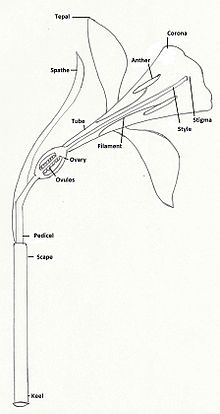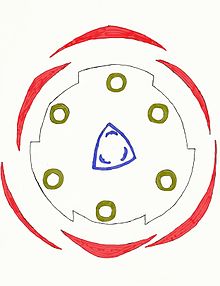
Back Healswyrt ANG نرجس (نبات) Arabic نرجس (جنس من النباتات) ARZ Narcissus AST Nərgizgülü Azerbaijani Нарцыс (род раслін) Byelorussian Нарцис (цвете) Bulgarian নার্গিস (ফুল) Bengali/Bangla ཆུ་ལྷ། Tibetan Roz-kamm Breton
| Narcissus Temporal range: Late Oligocene – Recent
| |
|---|---|

| |
| Narcissus poeticus | |
| Scientific classification | |
| Kingdom: | Plantae |
| Clade: | Tracheophytes |
| Clade: | Angiosperms |
| Clade: | Monocots |
| Order: | Asparagales |
| Family: | Amaryllidaceae |
| Subfamily: | Amaryllidoideae |
| Tribe: | Narcisseae |
| Genus: | Narcissus L.[1] |
| Type species | |
| Narcissus poeticus | |
| Subgenera | |



| Floral formula | |
| Br ✶ ☿ P3+3+Corona A3+3 G(3) Bracteate, Actinomorphic, Bisexual Perianth: 6 tepals in 2 whorls of 3 Stamens: 2 whorls of 3 Ovary: Superior – 3 fused carpels |
Narcissus is a genus of predominantly spring flowering perennial plants of the amaryllis family, Amaryllidaceae. Various common names including daffodil,[Note 1] narcissus and jonquil, are used to describe all or some members of the genus. Narcissus has conspicuous flowers with six petal-like tepals surmounted by a cup- or trumpet-shaped corona. The flowers are generally white and yellow (also orange or pink in garden varieties), with either uniform or contrasting coloured tepals and corona.
Narcissi were well known in ancient civilisation, both medicinally and botanically, but were formally described by Linnaeus in his Species Plantarum (1753). The genus is generally considered to have about ten sections with approximately 36 species. The number of species has varied, depending on how they are classified, due to similarity between species and hybridisation. The genus arose some time in the Late Oligocene to Early Miocene epochs, in the Iberian peninsula and adjacent areas of southwest Europe. The exact origin of the name Narcissus is unknown, but it is often linked to a Greek word (ancient Greek ναρκῶ narkō, "to make numb") and the myth of the youth of that name who fell in love with his own reflection. In some versions of the story, Narcissus is turned in to a flower by the Gods after his death. The English word "daffodil" appears to be derived from "asphodel", with which it was commonly compared.
The species are native to meadows and woods in southern Europe and North Africa with a centre of diversity in the Western Mediterranean, particularly the Iberian peninsula. Both wild and cultivated plants have naturalised widely, and were introduced into the Far East prior to the tenth century. Narcissi tend to be long-lived bulbs, which propagate by division, but are also insect-pollinated. Known pests, diseases and disorders include viruses, fungi, the larvae of flies, mites and nematodes. Some Narcissus species have become extinct, while others are threatened by increasing urbanisation and tourism.
Historical accounts suggest narcissi have been cultivated from the earliest times, but became increasingly popular in Europe after the 16th century and by the late 19th century were an important commercial crop centred primarily in the Netherlands. Today narcissi are popular as cut flowers and as ornamental plants in private and public gardens. The long history of breeding has resulted in thousands of different cultivars. For horticultural purposes, narcissi are classified into divisions, covering a wide range of shapes and colours. Like other members of their family, narcissi produce a number of different alkaloids, which provide some protection for the plant, but may be poisonous if accidentally ingested. This property has been exploited for medicinal use in traditional healing and has resulted in the production of galantamine for the treatment of Alzheimer's dementia. Long celebrated in art and literature, narcissi are associated with a number of themes in different cultures, ranging from death to good fortune, and as symbols of spring.
The daffodil is the national flower of Wales and the symbol of cancer charities in many countries. The appearance of wild flowers in spring is associated with festivals in many places.
- ^ Cite error: The named reference
LinSPwas invoked but never defined (see the help page). - ^ Thomé 1903, p. 316.
Cite error: There are <ref group=Note> tags on this page, but the references will not show without a {{reflist|group=Note}} template (see the help page).
© MMXXIII Rich X Search. We shall prevail. All rights reserved. Rich X Search